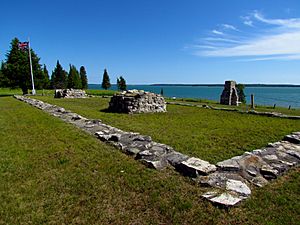Fort St. Joseph (Ontario) facts for kids
 |
|
| Established | 1796 |
|---|---|
| Location | Jocelyn, Ontario, Canada, on Lake Huron |
| Type | Fort |
| Designated: | 1923 |
Fort St. Joseph was an old British fort located on the southern tip of St. Joseph Island in Ontario, Canada. It sits right on the shores of Lake Huron. This fort was made up of several buildings. These included a blockhouse, a place to store gunpowder, a bakery, and a meeting house for Indigenous people. All these buildings were protected by a strong wooden fence called a palisade.
The fort covered about 325 hectares (about 800 acres) along the St. Marys River. It was a very important military spot for the British. Fort St. Joseph was also a key place for trading goods in the area. It was the starting point for the first attack in the War of 1812. For a short time, it was the most western British fort in North America. Today, Parks Canada looks after Fort St. Joseph. It is now known as a National Historic Site of Canada.
Contents
History of Fort St. Joseph
Why the Fort Was Built
After the Treaty of Paris was signed in 1783, the United States became a new country. They gained control of Michilimackinac. This was a trading post on Mackinac Island where Lake Huron and Lake Michigan meet. This location gave the Americans strong control over the upper Great Lakes.
Lord Dorchester, who was the military governor of Canada, worried about this. He quickly decided that the British needed to take over St. Joseph Island. He feared the Americans might claim it first. Lord Dorchester hoped that a new fort there could compete with Michilimackinac. He also wanted to keep the support of the Indigenous peoples.
New Borders and New Forts
The situation became clearer with Jay's Treaty. This agreement started in 1796. It meant that British soldiers had to leave forts that were now American territory. Fort Mackinac was one of these forts. To replace it, the British began building Fort St. Joseph in the summer of 1796.
Challenges Before the War
By 1807, relations between the British and Americans were tense. This was due to disagreements over trade and foreign policies. Control over the Great Lakes and the fur trade also caused problems. Fort St. Joseph was not yet finished. It had too few soldiers and old weapons. It was clear the fort would not be ready to defend itself if attacked.
Fort St. Joseph and the War of 1812
The United States declared war on Great Britain on June 18, 1812. Major-General Sir Isaac Brock was the military commander of Upper Canada. He understood how important Fort St. Joseph was. He sent a message to Captain Charles Roberts, who commanded Fort St. Joseph. The order was to prepare for an immediate attack on Michilimackinac.
On July 16, 1812, Captain Roberts led his army. It included British soldiers and French Canadian voyageurs. Many voyageurs were from nearby Sault Ste. Marie. About 400 Indigenous warriors also joined them. These warriors were from the Ottawa, Ojibwa, Menominee, and Winnebago nations. They set off in boats towards Fort Michilimackinac.
The mission went smoothly. The force landed at British Landing on Mackinac Island on the morning of July 17, 1812. Lieutenant Porter Hanks, who commanded Fort Michilimackinac, was not ready for an attack. His fort had very few soldiers. Before Lieutenant Hanks' men could react, Captain Roberts' army was already in position. Lieutenant Hanks had no choice but to surrender.
Meanwhile, American soldiers from Detroit arrived at Fort St. Joseph. They found the fort empty. They then burned the fort and the North West Company storehouses there.
After the War
Michilimackinac remained under British control until the end of the war. However, a peace treaty was signed in December 1814. This treaty gave Michilimackinac back to the Americans. The British decided not to rebuild Fort St. Joseph.
Instead, the British built a new fort on Drummond Island. This island is located between St. Joseph Island and Mackinac Island. They still used the gunpowder storage building at the abandoned Fort St. Joseph. Later, the British moved their soldiers to Penetanguishene. This happened after the fur trade became less important. Fort St. Joseph was then largely forgotten.
Fort St. Joseph Today
For many years, no one paid much attention to the old fort. In the early 1920s, the Sault Ste. Marie Historical Society began to explore the ruins. After World War II, a road was built to the site. A small picnic area was also created.
The University of Toronto became interested in the site in the late 1950s. Teams started archaeological digs in the summers of 1963 and 1964. It was not until 1974 that Parks Canada took control of the site. A visitor centre was then built for people to learn about the fort.
Today, archaeological digs still happen sometimes. Each new dig helps discover many new artifacts. The park welcomes a few thousand visitors every year.
See also
- Chronology of the War of 1812
- War of 1812 Campaigns
- List of forts
- Upper Canada
- Fort Mackinac
- Islands of the Great Lakes
- Sault Ste. Marie, Ontario
Affiliations
The Museum is affiliated with: CMA, CHIN, and Virtual Museum of Canada.

